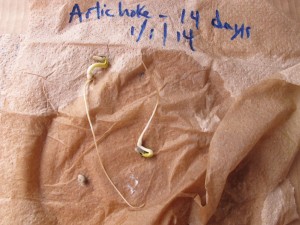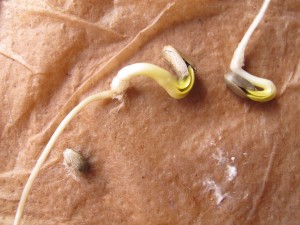Starting from Seeds
The seed catalogs have been arriving in my post office box for weeks now, and I‘ve been reading them and dreaming of fat, juicy tomatoes and sweet crunchy cucumbers. It’s too early to plant seeds indoors, but I’m getting ready now.
The first step in starting plants from seed is always to sort out what seeds I have, and to throw out the seeds that are past their “best used by” date. As a general rule I use three years as limit for keeping and using seeds. There are a few things that will last longer, and a few that are best bought each year. But 3 years is a good rule of thumb. You might want to test a few seeds you have left in the closet now to see if they will germinate.
Here is how to test for seed viability: count out 10 seeds and place them on a good tough paper towel, and label the towel with a waterproof marker or pencil. Dampen the towel, fold it over a few times and place it in a zipper bag. I left the bags open, thinking that a sealed bag might promote rotting of the seeds, but in one case, the paper towel dried out in places – which is sure death to seeds just starting. I checked the seeds after 1 week (nothing) and after 2 weeks. Some seeds may require even longer.
There are a few seeds that are worth buying every year as they do not germinate well, even on their second year. Among those are corn, onions, parsnips and parsley. And you can do a test germination if you wish for seeds that are 3 years old or more. This year I tried 2 kinds of onions (to test the 1-year rule), artichokes and celeriac (supposedly good for 5 years).
The onions germinated poorly, as forecast. 30% of one variety germinated, none of another. The artichokes germinated poorly, but the paper had gotten a bit dry. I only tried 5 seeds, and 2 of them germinated in the second week, sending out 3 inch roots and incipient leaves. I then planted those two seedlings in a large, deep pot – because I have a hard time killing plants. And artichokes take a long time to develop big plants, so I thought I’d let a few get an early start.
How you store your seeds makes a difference in viability, too. I store half-used seed packets in open zipper bags on a shelf in a closet. It gets neither excessively hot nor cold in the closet, and the humidity is neither high nor low, in general. Remember that seeds have living tissue inside, so overheating or drying out completely would be bad – though some seeds seem to have outer coverings as tough as any plastic. And freezing seeds does not seem to harm them, and that is the way most seed banks store their seeds.
Also at this time of year you can begin to assemble all the supplies and equipment needed for growing seedlings indoors. That means cleaning out all of lsat year’s pots and 6-packs for starting seedlings, and buying new ones as needed. As a general rule, the deeper the containers, the better. When buying 6-packs for your seeds, always get the biggest, deepest that you can. Instead of economizing and getting packs that are 72 to a tray, look for those that are just 36 to tray instead.
I also need to find (and clean up) any of the plastic domes I use to cover the trays of started seeds. These are reusable clear plastic covers that fit nicely over a tray and hold in moisture and heat. Seeds that dry out when just germinating do not survive, and these lids are great at containing moisture. I remove them once most seeds in a tray have started to grow.
Heat mats are also useful in starting seeds. I place seed trays on them to give a little bottom heat. Seeds germinate better and sooner with bottom heat, which makes sense. Seeds in the wild (without my help and supervision) shouldn’t germinate in winter – the seedlings would freeze. But warm soil tells the seeds that summer has arrived – hence the heat mats (to trick them). Available at garden centers.
Over the eons, plants have developed triggers for germination including temperature, presence of moisture, and, for some, sunshine. The photo-trigger means that seeds rototilled deeply won’t germinate – which is why I don’t rototill: weed seeds will germinate if brought to the surface.
Seedlings often do not do well if planted in garden soil indoors. There is no breeze and no direct sunshine in doors, so they may develop a fungal disease known as “damping off”. Outdoors it is not generally a problem. But it is best to buy “potting mix” or “seed starting mix”. This fluffy stuff is generally peat-based and sterile. I like to mix it 50-50 with compost, either my own or out of a bag. If you have it in your barn, be sure you thaw it out well in advance.
It’s still too early to plant most things. Onions and artichokes can be started in February, and sometimes I start hot peppers then. In general I like to start tomatoes and other annuals in early April so that they don’t get too big indoors. But it’s never too early to get organized and ready.
Henry Homeyer is a gardener, gardening teacher and consultant. His Web site is www.Gardening-Guy.com. he is the author of 4 gardening books and lives in Cornish Flat, NH




